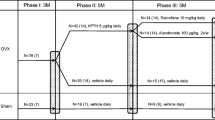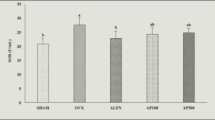Abstract
Objective
To compare the effects of β-cryptoxanthin (β-cry) from citrus fruit on bone-formation parameters in the distal femoral epiphysis of ovariectomized (OVX) mice with the effects of osteoporosis therapeutic agents.
Methods
Ten-week-old OVX ICR mice were used. The mice were divided into five experimental groups: β-cry; bisphosphonate (treatment with the bone resorption inhibitor risedronate); vitamin K2 [treatment with the bone formation stimulator and bone resorption inhibitor menaquinone 4 (MK4)]; OVX control; and sham (no OVX). Risedronate was used as the bisphosphonate (risedronate group), and menaquinone 4 was used as vitamin K2 (MK4 group). Risedronate was administered orally, and β-cry and MK4 were mixed with the regular feed. The mice were fed the diets for 2 months. Femurs were resected, and blood samples were collected. Bone mineral density (BMD) was analyzed by peripheral quantitative computed tomography. Microcomputed tomography was also performed to evaluate the three-dimensional structure of the trabecular bone.
Results
In contrast to the risedronate and MK4 groups, there was no improvement in the trabecular BMD, cortical thickness, or periosteal perimeter in the β-cry group. Trabecular structural parameters including the morphometric indices, continuity index, and connectivity index were significantly improved in the β-cry group compared with the OVX control group. In particular, there was a marked improvement in morphometric indices.
Conclusion
β-Cry improved the trabecular structure. This suggests that β-cry might be useful as a dietary supplement to prevent bone degeneration and osteoporosis associated with aging.

Similar content being viewed by others
References
Chew BP, Park JS. Carotenoids action on the immune response. J Nutr. 2004;134:257–61.
De Stefani E, Brennan P, Boffeta P, Roncol A, Mendilaharsu M, Deneoellegrini H. Vegetables, fruits, related dietary antioxidants, and risk of squamous cell carcinoma of the esophagus: a case-control study in Uruguay. Nutr Cancer. 2000;38:23–9.
Goodman MT, McDuffie K, Hernandez B, Hankin JH, Wilkens LR, Franke AA, et al. The association of plasma micronutrients with the risk of cervical atypical squamous cells of undetermined significance (ASCUS). Asian Pac J Cancer Prev. 2000;1:337–45.
Zeegers MP, Goldbohm RA, van den Brandt PA. Are retinol, vitamin C, vitamin E, folate and carotenoids intake associated with bladder cancer risk? Results from the Netherlands Cohort Study. Br J Cancer. 2001;85:977–83.
Yuan JM, Stram DO, Arakawa K, Lee HP, Yu MC. Dietary cryptoxanthin and reduced risk of lung cancer: the Singapore Chinese Health Study. Cancer Epidemiol Biomarkers Prev. 2003;12:890–8.
Mannisto S, Smith-Warner SA, Spiegelman D, Aldanes D, Anderson K, Van den Brandt PA, et al. Dietary carotenoids and risk of lung cancer in a pooled analysis of seven cohort studies. Cancer Epidemiol Biomarkers Prev. 2004;13:40–8.
Montonen J, Knekt P, Jarvinen R, Reunanen A. Dietary antioxidant intake and risk of type 2 diabetes. Diabetes Care. 2004;27:362–6.
Cerhan JR, Saag KG, Merlino LA, Mikuls TR, Lindsey A. Antioxidant micronutrients and risk of rheumatoid arthritis in a cohort of older women. Am J Epidemiol. 2003;157:345–54.
New SA. Intake of fruit and vegetables: implications for bone health. Proc Nutr Soc. 2003;62:889–99.
Macdonald HM, New SA, Golden MH, Campbell MK, Reid DM. Nutritional associations with bone loss during the menopausal transition: evidence of a beneficial effect of calcium, alcohol, and fruit and vegetable nutrients and of a detrimental effect of fatty acids. Am J Clin Nutr. 2004;79:155–65.
Yamaguchi M, Uchiyama S. Effect of carotenoid on calcium content and alkaline phosphatase activity in rat femoral tissues in vitro: the unique anabolic effect of β-cryptoxanthin. Biol Pharm Bull. 2003;26:1189–91.
Yamagichi M, Uchiyama S. β-Cryptoxanthin stimulates bone formation and inhibits bone resorption in tissue culture in vitro. Mol Cell Biochem. 2004;258:137–44.
Uchiyama S, Yamaguchi S. Oral administration of β-cryptoxanthin induces anabolic effects on bone components in the femoral tissues of rats in vivo. Biol Pharm Bull. 2004;27:232–5.
Uchiyama S, Yamaguchi M. Inhibitory effects of β-cryptoxanthin on osteoclast-like cell formation in mouse marrow cultures. Biochem Pharmacol. 2004;67:1297–305.
Watts NB. Bisphosphonate treatment of osteoporosis. Clin Geriatr Med. 2003;19:395–414.
Shiraki M, Shiraki Y, Aoki C, Miura M. Vitamin K2 (menatetrenone) effectively prevents fractures and sustains lumbar bone mineral density in osteoporosis. J Bone Miner Res. 2000;15:515–21.
Hara K, Kobayashi M, Akiyama Y. Vitamin K2 (menatetrenone) inhibits bone loss induced by prednisolone partly through enhancement of bone formation in rats. Bone. 2002;31:575–81.
Hara K, Akiyama Y, Nakamura T, Murota S, Morita I. The inhibitory effect of vitamin K2 (menatetrenone) on bone resorption may be related to its side chain. Bone. 1995;16:179–84.
Ferreti JL. Peripheral quantitative computed tomography for evaluating structural and mechanical properties of small bone. In: An YH, Draughn RA, editors. Mechanical testing of bone and the bone-implant interface. Florida: Boca Rato CRC; 2000. p. 390–2.
RATOC System Engineering Co., Ltd. TRI/3D-BON. Basic operation manual. RATOC System Engineering Co., Ltd. 2002.
Parfitt AM, Matthews CHE, Villanueva AR, Kleerekoper M, Frame B, Rao DS. Relationships between surface, volume, and thickness of iliac trabecular bone in aging and in osteoporosis. J Clin Invest. 1983;72:1396–409.
Odgaad A. Three-dimensional methods for quantification of cancellous bone architecture. Bone. 1997;20:315–28.
Feldkamp LA, Goldstein SA, Parfitt AM, Jesion G, Kleerekoper M. The direct examination of three-dimensional bone architecture in vitro by computed tomography. J Bone Miner Res. 1989;4:3–11.
Ikuta A, Kumasaka S, Kashima I. Quantitative analysis using the star volume method applied to skeleton patterns extracted with a morphological filter. J Bone Miner Metab. 2000;8:271–7.
Kumasaka S, Kiyohara S, Takahashi T, Asai H, Kashima I. Morphologically extracted trabecular skeleton superimposed upon digital radiograph structure. J Bone Miner Metab. 2000;18:208–11.
Vesterby A, Gunndersen HJG, Melsen F. Star volume of marrow space and trabeculae of the first lumbar vertebra: sampling efficiency and biological variation. Bone. 1989;10:7–13.
Nakamura K, Matsubara M, Asai H, Koyama A, Fujikawa T, Kashima I. Mathematical morphology for extraction of bone trabecular pattern: preliminary investigation of quantitative analysis using the star volume. J Jpn Soc Bone Morphom. 1999;9:45–51.
Garrahan NJ, Mellish RW, Compston JE. A new method for the two-dimensional analysis of bone structure in human iliac crest biopsies. J Microsc. 1986;142:341–9.
Croucher PI, Garrahan NJ, Compston JE. Assessment of cancellous bone structure: comparison of strut analysis, trabecular bone pattern factor, and marrow space star volume. J Bone Miner Res. 1996;11:955–61.
Kanis JA, Johnell O, De Laet C, Jonsson B, Oden A, Ogelsby AK. International variations in hip fracture probabilities: implications for risk assessment. J Bone Miner Res. 2002;17:1237–44.
Matkovic V, Jelic T, Wardlaw GM, Ilich JZ, Goel PK, Wright JK, et al. Timing of peak bone mass in Caucasian females and its implication for the prevention of osteoporosis. Inference from a cross-sectional model. J Clin Invest. 1994;93:799–808.
Glastre C, Braillon P, David L, Cochat P, Meunier PJ, Delmas PD. Measurement of bone mineral content of lumbar spine by dual energy x-ray absorptiometry in normal children: correlations with growth parameters. J Clin Endocrinol Metab. 1990;70:1330–3.
Bonjour JP, Theintz G, Buchs B, Slosman D, Rizzoli R. Critical years and stages of puberty for spinal and femoral bone mass accumulation during adolescence. J Clin Endocrinol Metab. 1991;73:555–63.
Lu PW, Briody JN, Ogle GD, Morley K, Humphries IR, Allen J, et al. Bone mineral density of total body, spine, and femoral neck in children and young adults: a cross-sectional and longitudinal study. J Bone Miner Res. 1994;9:1451–8.
Ettinger B, Black DM, Mitlak BH, Knickerbocker RK, Nickelsen T, Genant HK, et al. Reduction of vertebral fracture risk in postmenopausal women with osteoporosis treated with raloxifene: results from a 3-year randomized clinical trial. Multiple Outcomes of Raloxifene Evaluation (MORE) Investigators. JAMA. 1999;282:637–45.
Clowes JA, Peel N, Eastell R. Glucocorticoid-induced osteoporosis. Curr Opin Rheumatol. 2001;13:326–32.
Gutteridge DH, Stewart GO, Prince RL, Price RI, Retallack RW, Dhaliwal SS, et al. A randomized trial of sodium fluoride (60 mg) ± estrogen in postmenopausal osteoporotic vertebral fractures: increased vertebral fractures and peripheral bone loss with sodium fluoride; concurrent estrogen prevents peripheral loss, but not vertebral fractures. Osteoporos Int. 2002;13:158–70.
Akedo Y, Hosoi T, Inoue S, Ikegami A, Mizuno Y, Kaneki M, et al. Vitamin K2 modulates proliferation and function of osteoblastic cells in vitro. Biochem Biophys Res Commun. 1992;187:814–20.
Hughes DE, Wright KR, Uy HL, Sasaki A, Yoneda T, Roodman GD, et al. Bisphosphonates promote apoptosis in murine osteoclasts in vitro and in vitro. J Bone Miner Res. 1995;10:1478–87.
Luckman SP, Hughes DE, Coxon FP, Russell RGG, Rogers MJ. Nitrogen-containing bisphosphonates inhibit the mevalonate pathway and prevent post-translational prenylation of GTP-binding proteins, including Ras. J Bone Miner Res. 1998;13:581–9.
Suzuki K, Takeyama S, Kikuchi T, Yamada S, Sodek J, Shinoda H. Osteoclast responses to lipopolysaccharide, parathyroid hormone and bisphosphonates in neonatal murine calvaria analyzed by laser scanning confocal microscopy. J Histohem Cytochem. 2005;53:1525–37.
Meunier PJ, Delmas PD, Eastell R, McClung MR, Papapoulos S, Rizzoli R, et al. Diagnosis and management of osteoporosis in postmenopausal women: clinical guidelines. International Committee for Osteoporosis Clinical Guidelines. Clin Ther. 1999;21:1025–44.
Black DM, Thomason DE, Bauer DC, Ensrud K, Musliner T, Hochberg MC, et al. Fracture risk reduction with alendronate in women with osteoporosis: the Fracture Intervention Trial. FIT Research Group. J Clin Endocrinol Metab. 2000;85:4118–24.
Watts NB, Josse RG, Hamdy RC, Hughes RA, Manhart MD, Barton I, et al. Risedronate prevents new vertebral fractures in postmenopausal women at high risk. J Clin Endocrinol Metab. 2003;88:542–9.
NIH Consensus Development Panel on Osteoporosis Prevention, Diagnosis, and Therapy. Osteoporosis prevention, diagnosis, and therapy. JAMA. 2001;285:785–95.
Yamaguchi M, Taguchi H, Gao YH, Igarashi A, Tsukamoto Y. Effect of vitamin K2 (menaquinone-7) in fermented soybean (natto) on bone loss in ovariectomized rats. J Bone Miner Metab. 1999;17:23–9.
Kaneki M, Hedges SJ, Hosoi T, Fujiwara S, Lyons A, Crean SJ, et al. Japanese fermented soybean food as the major determinant of the large geographic difference in circulating levels of vitamin K2: possible implications for hip-fracture risk. Nutrition. 2001;17:315–21.
Yano M, Kato M, Ikoma Y, Kawasaki A, Fukazawa Y, Sugiura M, et al. Quantitation of carotenoids in raw and processed fruits in Japan. Food Sci Technol Res. 2005;11:13–8.
Sugiura M, Matsumoto H, Kato M, Ikoma M, Yano M, Nagano A. Multiple linear regression analysis of the seasonal changes in the serum concentration of β-cryptoxanthin. J Nutr Sci Vitaminol. 2004;50:196–202.
Albanes D, Virtamo J, Taylor PR, Rautalahti M, Pietinen P, Heinonen OP. Effects of supplemental β-carotene, cigarette smoking, and alcohol consumption on serum carotenoids in the Alpha-Tocopherol, β-Carotene Cancer Prevention Study. Am J Clin Nutr. 1997;66:366–72.
Conflict of interest
There are no financial or other relation that could lead to a conflict of interest.
Author information
Authors and Affiliations
Corresponding author
Rights and permissions
About this article
Cite this article
Iino, M., Kozai, Y., Kawamata, R. et al. Effects of β-cryptoxanthin on bone-formation parameters in the distal femoral epiphysis of ovariectomized mice. Oral Radiol 30, 1–8 (2014). https://doi.org/10.1007/s11282-013-0131-7
Received:
Accepted:
Published:
Issue Date:
DOI: https://doi.org/10.1007/s11282-013-0131-7




